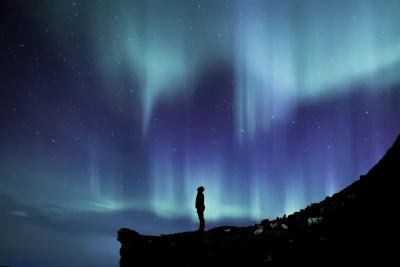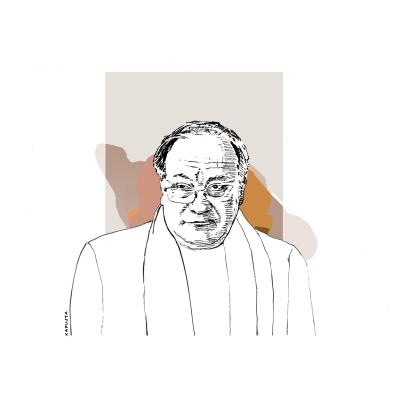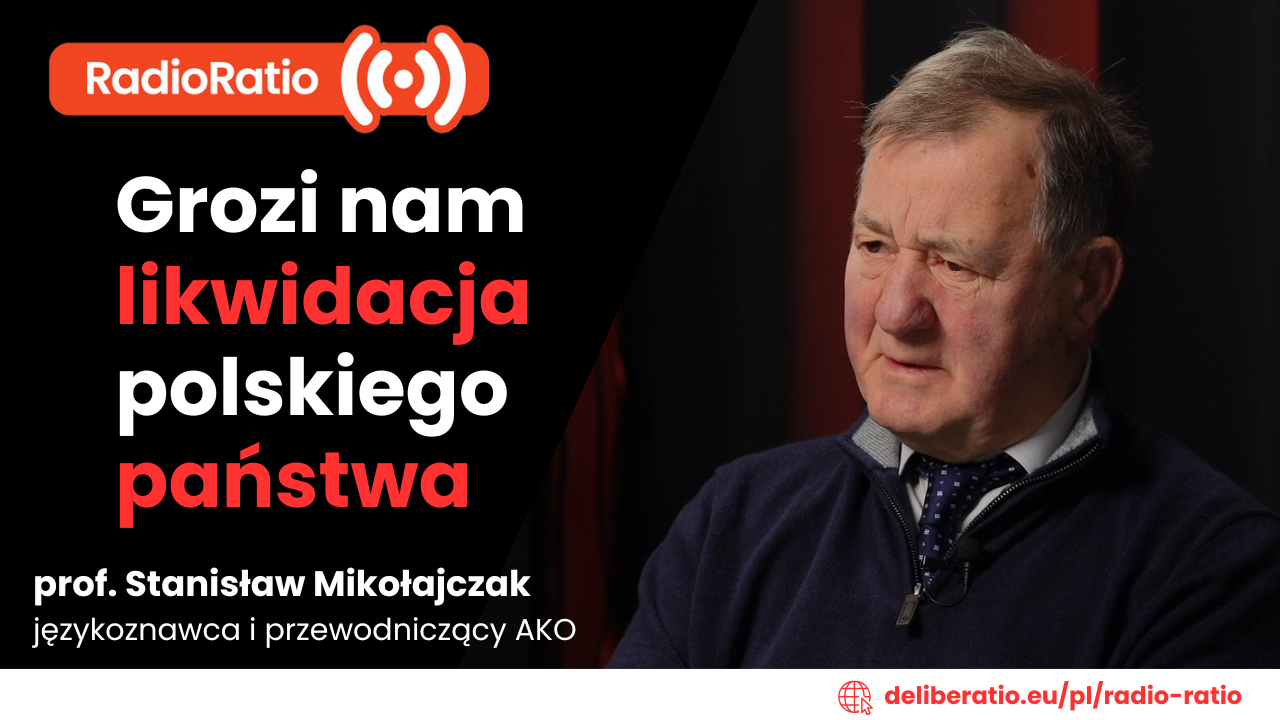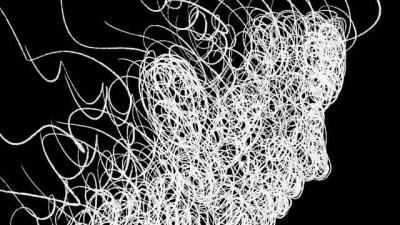The world is divided into the visible and the invisible. With the explosion of lower quality images to which we are subjected by mass culture, combined with a utilitarian conception of life, awareness of this parallel, invisible world disappears. Art, because it is entirely symbolic, is immersed in the invisible.
Care of the good spirits
The notion of the visible and invisible in art was often evoked by Jerzy Mierzejewski, a painter who died in 2012. By becoming friends with him, I became a follower of a particular tradition of thinking about art and making images, not art. Why do I emphasise that it is about creating images and not art?
Perhaps art ends when we are too aware that we are making art and want to be artists. Like love, we cannot command the heart to love one person, not another. The heart mocks us in such a situation. The boredom of contemporary galleries probably in this has its source. Duchamp’s genius lies in his awareness of this, and his art is a mockery of what will be in the art after him. Most of these creations mock us vividly, often beyond the consciousness of their creators, who are prisoners of the symbolic capital created by malignant geniuses. Creators, on the other hand, are strangers to the principle of restraint. As in life, some things are better not done than done. I knew a good poet who gave up writing and set up a vegetable stall. Intellectual circles known for their tolerance and free judgement ruled unequivocally: he was crazy!
But there is another tradition, difficult to grasp, I admit, but as real as feelings and a spirit that I have not seen but whose existence I am sure of because I breathe, think and am aware of. This invisible spirit is powerful; it demands its image, its visualisation. This spirit is emotions and feelings, and the background is harmony or mathematics. The bright side of it is the love of being. It is present when the mother prepares the meal by arranging the plates aesthetically and placing green cucumbers on the plate next to the red tomatoes. This spirit prompts the cooks to carefully prepare lunch for the pre-schoolers. The point of reference is the hard-to-define concept of beauty and harmony, which manifests itself in the decorative instinct of man. The classical Platonic definition of art and beauty, it is the translucence of ideas, of spirit in sensual material. The painter is qualitatively no different from mummies and kitchen ladies. At this point, he is radically speaking against the corporate conception of the artistic world, which is subject to economic metabolism.
Slavishly subservient to it, artists and curators understandably question the disinterestedness of art as such. But not all of them do. Breaking out of the metabolism and resisting it is also a measure of talent. A highly significant example is that of Rembrandt and his “Night Watch” painting, in which Rembrandt, in the name of his own artistic vision, took in parentheses the expectations of those who commissioned the painting from him. He degraded himself economically. There must be some invisible force at work here, independent of common taste and financial expectations. This force causes the artist to be “possessed” by a spirit of harmony, a spirit of a higher order, of beauty. This force, spirit, and energy, all obviously invisible, find a tool for self-expression in the artist. Here is a caveat: Czesław Milosz, in Ars Poetica, remarked that it is good when good spirits nevertheless have him in their protection.
Phenomenology and painting
Let me make a caveat. Painting is not philosophy. The latter is useful as an aid in describing the practice of painting, but, in relation to what art is and the poetic disposition fundamental to it, it remains, as Harold Bloom observed, only a “dead bird”. When we talk about ideas in art, it is worth recalling the perfect model. Without a point of reference, the creator is like a blind person.
Imagine a painter who seeks a point of reference in infinite space and defines space as a collection of all points. His entire being, his entire vital energy, is harnessed to the battle against time by means of the two-dimensional plane of the canvas. This is the perfect painter. What does it mean to seek points of support in space? In the case of the painter, it is about legitimising the image that emerges from what he sees and in a way that presupposes the elimination of all unnecessary, superfluous assumptions. Roughly speaking, this is a phenomenological attitude. Phenomenology is the twentieth-century incarnation of Platonic-type thinking. Whoever reads Plato and contemplates his philosophy must encounter the limit of visibility, the enigma of the constitution of the world precisely in the form of images must enter the depths, the second, third meaning of images - or else reject it all as the delusion of a mad mind. But even if we are dealing with a delusion, it is one that occupies the imagination enough to succumb to it. I succumbed to it. If we are in the business of painting pictures and not making art objects, well, at first glance, we are doing something vaguely original, without assumptions, which means I am expressing some social idea that catches the public eye. Because what is less original than another kitschy sunset? There seems to be nothing to talk about when we see something obvious. This is where the problems of interpretation come from because what to write about when there is basically nothing to write about? But when I think of superfluous elements or assumptions, I think of those that have come to painting from other spaces, not necessarily for this noble occupation’s benefit. I am talking about ideological content and philosophical or religious assumptions taken as theses. Much can be written about these things. The adoption of assumptions facilitates creation because it serves to legitimise it, but at the same time, it introduces an element of mediation that reduces the image to an illustration, or the work becomes a testimony to an artistic utopia because it loses contact with nature and is merely decoration like geometric abstraction.
Metaphysical activity
To paint a picture that is an image of the world, without this mediation, only one assumption is necessary, which is at the same time an intuition that requires no proof, that here, as a result of work, spiritual exercises, a visible reality is revealed to us, absolute in its own way, unquestionable. And this visible material is the object of “processing”, but not to reduce, to draw interesting accidents from it, but to give this whole reality a “new life”, the mark of something that tries to successfully outwit time by intensifying the image chosen by the painter’s sight, because there is “something” in it. How is this achieved? The first condition is personality. It determines the form. The form is reality, as seen through individuality. The artist has remained a sensitive metaphysical receptor since Romanticism, and many believe art is the last metaphysical activity in disenchanted Western culture. But it has always been fundamentally a metaphysical receptor. The metaphysical tradition we are talking about here is not necessarily religious. Once, in a conversation, Jerzy Mierzejewski remarked rather mysteriously that a painting must be like a stone that the painter can lift, lift out of the way.
What does it mean that a painting is heavy as a stone, and when is a painting heavy as a stone? Images of tragic events seem to be that way naturally. But this kind of heaviness is not the point here. It is about a painting that preserves the depth of the painter’s experience, and this is a perceptual-emotional depth and, at the same time, brings a visual-emotional truth that reaches us in a significant way, like a shock, similar to the one a person experiences when hearing Schubert’s Eighth “Unfinished” symphony, for example. In this way, through art, man learns something about himself.
Art is the business of the individual
Art is a matter of the individual and not of social groups. The socialisation of art detaches it from the metaphysical background revealed when the individual is confronted with fate. Art helps him in this confrontation. In this sense, it is intricately linked to life, but I emphasise again - the life of the individual human being and not social groups. Today, art that does not speak out on socially important issues is treated as indifferent to human fate. There could hardly be a greater misunderstanding. I insist that such art exists only in apparent detachment from life. It is firmly embedded in it, also acting in an ad hoc, very concrete way.
I have looked to literature for the answer that makes it possible to find a cognitive, life-illuminating aspect in 'asocial' art. Literature, but not in the sense of telling a story, in my opinion, reveals the basic sense of painting.
Let us recall Chekhov. We read Chekhov, his characterisations of people and life situations. We recognise in this something in which we participate or have participated. For example, the qualities of someone’s character from a gesture described by the writer. Often in life, such a gesture, which only we perceive, determines an attitude towards someone, sometimes everything. A gesture that defines a personality, something invisible that that person would like to hide. Chekhov’s stories reveal the depth and, at the same time, the demonic nature of life, the whole complex tangle of human relationships. The non-obviousness of the obvious. Chekhov teaches us how to act; we evaluate life through his talent. His art of writing reveals what remains invisible daily. Outstanding art shapes the “aesthetic imagination”, which becomes an unconscious guide in the search for higher-order pleasures.
The quality of this sensory experience of the world is linked by feedback precisely to the pleasure of “understanding” life. This is a very pragmatic function. There is another essential element of such a reading. It is the overcoming of loneliness. Even if I cannot relate to my contemporaries because fierce competition deprives us of that “which is human” and everyone is a monad convinced of their uniqueness, at least with Chekhov, I know who they are because I have already met them in stories and reading reduces the burden of loneliness. I am beginning, whether I want to or not, to see the world through Chekhov’s eyes, that is, gradually to rise to his level of consciousness and see things that are inaccessible to me. I now turn to the painting. Something similar is the case with a good painting. It is just about a different range of experience, and this is due to the differentia specifica of each art discipline.
Eye awareness and perceptual depth
It is all about perceptual depth and “eye-consciousness”. This is a concept taken from Strzemiński. To make my interpretation more precise, I will distinguish two cognitive planes in this “eye-consciousness”, for it can be interpreted in a narrower or broader scope. Let us begin with the more limited scope.
Cezanne used to say that a painter is someone who paints eight hours a day and can paint a white wall. What I will say now is evident to painters, but I think it is worth pointing out again. You can “run” a roller with white emulsion over a canvas, which is how you paint a white wall. But one can also build it from what the eye chases as it looks, analyses, meditates, and contemplates the events on the white wall. The first will be the work of the room painter, the white wall. The second will be the painting of the wall because what happens between the plane of the eye and the plane of the wall will be painted. The painter always paints a space, not an object. If he paints a picture with an “eye” that has been chasing light all its life, analysing the “knitting of visibility”, the picture created will be like a stone lifted from the road, that is, from the river of images in which we are immersed. And such a painting, if I have this “potential consciousness of the eye” within me, will teach me to look and widen the scope of perception of visible reality, just as Chekhov widened the scope of reading the complex invisible world of human psychological relationships.
We have been talking about the aesthetic sphere, related to the expansion of perception, and this is this narrower interpretation of “eye awareness”. But there is another level. The second broader interpretation. “Eye-consciousness” in the first degree is in a way self-evident and marks every medium-talented painter. This second, broader interpretation is rare in art; it marks the greatest. It is obviously a unity that cannot be divided when it appears. But it is exceedingly rare. What conclusions can be drawn for painting from this? When, for example, a painter paints a portrait, he does not paint a likeness, an image, but who the person is because the painter, armed with this broader awareness of the eye, can discern this from gestures, body language, and to paint an aura which is solely and exclusively connected with the person he is painting. It is easier to make judgements about a person in general than to know a single person in depth, Rochefoucauld noted. Such a painter paints the invisible. As the Polish psychiatrist Antoni Kępiński pointed out, modern doctors could learn about man, even diagnosis, from the portraits of the old masters. The invisible is hidden in the obvious. “Eye awareness” is the ability to see further, broader, and deeper and the ability to paint this vision. Many people have this ability, but only a few can express it in art, painting, in literature. Revealing nature in its most sensitive registers in a painting is cognitive energy given to the onlookers so that it reveals itself in them and awakens them. We are speaking here, of course, of feelings that are of invisible nature. Furthermore, the encounter with such a painting is also, as in literature, a way of breaking through loneliness.
Thanks to this timeless content hidden in the form of a work of art, Vermeer’s, Rembrandt’s, or Cezanne’s paintings obviously speak to us, and they will continue to do so as long as people remain potentially open to this invisible aspect that constitutes the world. For relationships between people are of invisible nature, the feeling of friendship or love.
The painter reveals intangible things that the ordinary person does not see, and through the painter can see and confirm that they are close to him, like a flash of something remarkably familiar, but elusive on a daily basis, which is hidden from us for some reason. The implicitness may simply arise from the nature of being. At the same time, when we speak of elusiveness, we automatically think of extraordinary things. The essence and purpose of the art of painting are shown by comparing it to photography. Driven by instinct, the painter looks for places where seemingly nothing is happening because he is yet to bring out the vitality of that place, to create it. The painter chooses what is rather modest, what reveals its depth. The photographer looks for striking arrangements that are extraordinary.
“The aspects of things that are most important for us”, Ludwig Wittgenstein observed, “are hidden because of their simplicity and familiarity. Man pays no attention to the real foundations of his enquiry. Unless ‘it’ just strikes him”.
Read also
On Confusion in Contemporary Art
There is perhaps no more heated dispute in culture than that concerning contemporary art.












Comments (0)